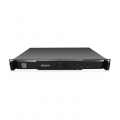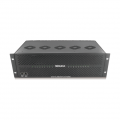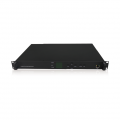What?s the HDMI? And How HDMI Works? | Soukacatv Digital modulatorPosted by Tracy He on March 28th, 2019 What’s the HDMI? HDMI (High-Definition Multimedia Interface) is a proprietary audio/video interface for transmitting uncompressed video data and compressed or uncompressed digital audio data from an HDMI-compliant source device, such as a display controller, to a compatible computer monitor, video projector, digital television, or digital audio device. HDMI is a digital replacement for analog video standards. HDMI implements the EIA/CEA-861 standards, which define video formats and waveforms, transport of compressed and uncompressed LPCM audio, auxiliary data, and implementations of the VESA EDID.(p. III) CEA-861 signals carried by HDMI are electrically compatible with the CEA-861 signals used by the Digital Visual Interface (DVI). No signal conversion is necessary, nor is there a loss of video quality when a DVI-to-HDMI adapter is used.The CEC (Consumer Electronics Control) capability allows HDMI devices to control each other when necessary and allows the user to operate multiple devices with one handheld remote control device. Several versions of HDMI have been developed and deployed since initial release of the technology, but all use the same cable and connector. Other than improved audio and video capacity, performance, resolution and color spaces, newer versions have optional advanced features such as 3D, Ethernet data connection, and CEC (Consumer Electronics Control) extensions. Production of consumer HDMI products started in late 2003.In Europe either DVI-HDCP or HDMI is included in the HD ready in-store labeling specification for TV sets for HDTV, formulated by EICTA with SES Astra in 2005. HDMI began to appear on consumer HDTVs in 2004 and camcorders and digital still cameras in 2006.As of January 6, 2015 (twelve years after the release of the first HDMI specification), over 4 billion HDMI devices have been sold. Specifications The HDMI specification defines the protocols, signals, electrical interfaces and mechanical requirements of the standard.(p. V) The maximum pixel clock rate for HDMI 1.0 is 165 MHz, which is sufficient to allow 1080p and WUXGA (1920×1200) at 60 Hz. HDMI 1.3 increases that to 340 MHz, which allows for higher resolution (such as WQXGA, 2560×1600) across a single digital link.An HDMI connection can either be single-link (type A/C/D) or dual-link (type B) and can have a video pixel rate of 25 MHz to 340 MHz (for a single-link connection) or 25 MHz to 680 MHz (for a dual-link connection). Video formats with rates below 25 MHz (e.g., 13.5 MHz for 480i/NTSC) are transmitted using a pixel-repetition scheme. Audio/video HDMI uses the Consumer Electronics Association/Electronic Industries Alliance 861 standards. HDMI 1.0 to HDMI 1.2a uses the EIA/CEA-861-B video standard, HDMI 1.3 uses the CEA-861-D video standard, and HDMI 1.4 uses the CEA-861-E video standard.(p. III) The CEA-861-E document defines "video formats and waveforms; colorimetry and quantization; transport of compressed and uncompressed LPCM audio; carriage of auxiliary data; and implementations of the Video Electronics Standards Association (VESA) Enhanced Extended Display Identification Data Standard (E-EDID)".On July 15, 2013, the CEA announced the publication of CEA-861-F, a standard that can be used by interfaces such as DVI, HDMI, and LVDS.CEA-861-F adds the ability to transmit several Ultra HD video formats and additional color spaces. To ensure baseline compatibility between different HDMI sources and displays (as well as backward compatibility with the electrically compatible DVI standard) all HDMI devices must implement the sRGB color space at 8 bits per component.Ability to use the Y′CBCR color space and higher color depths ("deep color") is optional. HDMI permits sRGB 4:4:4 chroma subsampling (8–16 bits per component), xvYCC 4:4:4 chroma subsampling (8–16 bits per component), Y′CBCR 4:4:4 chroma subsampling (8–16 bits per component), or Y′CBCR 4:2:2 chroma subsampling (8–12 bits per component). The color spaces that can be used by HDMI are ITU-R BT.601, ITU-R BT.709-5 and IEC 61966-2-4. For digital audio, if an HDMI device has audio, it is required to implement the baseline format: stereo (uncompressed) PCM. Other formats are optional, with HDMI allowing up to 8 channels of uncompressed audio at sample sizes of 16-bit, 20-bit and 24-bit, with sample rates of 32 kHz, 44.1 kHz, 48 kHz, 88.2 kHz, 96 kHz, 176.4 kHz and 192 kHz. HDMI also carries any IEC 61937-compliant compressed audio stream, such as Dolby Digital and DTS, and up to 8 channels of one-bit DSD audio (used on Super Audio CDs) at rates up to four times that of Super Audio CD. With version 1.3, HDMI allows lossless compressed audio streams Dolby TrueHD and DTS-HD Master Audio.As with the Y′CBCR video, audio capability is optional. Audio return channel (ARC) is a feature introduced in the HDMI 1.4 standard. "Return" refers to the case where the audio comes from the TV and can be sent "upstream" to the AV receiver using the HDMI cable connected to the AV receiver.An example given on the HDMI website is that a TV that directly receives a terrestrial/satellite broadcast, or has a video source built in, sends the audio "upstream" to the AV receiver. The HDMI standard was not designed to pass closed caption data (for example, subtitles) to the television for decoding. As such, any closed caption stream must be decoded and included as an image in the video stream(s) prior to transmission over an HDMI cable to appear on the DTV. This limits the caption style (even for digital captions) to only that decoded at the source prior to HDMI transmission. This also prevents closed captions when transmission over HDMI is required for upconversion. For example, a DVD player that sends an upscaled 720p/1080i format via HDMI to an HDTV has no way to pass Closed Captioning data so that the HDTV can decode it, as there is no line 21 VBI in that format. Communication channels HDMI has three physically separate communication channels, which are the DDC, TMDS and the optional CEC.HDMI 1.4 added ARC and HEC. How HDMI Works If you've shopped for an HDTV, a PlayStation 3, or an HD-DVD or Blu-ray player, you've probably heard about HDMI. It can seem like just one of many connections on televisions or home-theater receivers. But HDMI is more than a port on the back of a TV (and the often expensive cable that fits inside). It's a set of rules for allowing high-definition electronic devices to communicate. Before the development of high-definition televisions, most TVs displayed pictures in what is now known as standard definition. The picture was roughly square -- its aspect ratio was 4:3. Its resolution, or the number of dots that make up the picture on the screen, was about 704 x 480 pixels. The picture was interlaced -- each piece of the moving image was really half a picture, but the pictures changed quickly enough that the human brain didn't really notice. Finally, older TVs relied on analog signals, which travel as a constantly varying electrical current. HDTVs, on the other hand, are digital. They use information in the form of ones and zeros. This information travels through cables as distinct electrical pulses. HDTVs have an aspect ratio of 16:9, so the picture is rectangular. They also have a higher resolution -- current HDTV standards allow for resolutions of up to 1920 x 1080 pixels. HDTV signals can also be progressive, meaning that the each frame of the moving image is a whole picture rather than half of one. So, compared to standard TVs, HDTVs have a wider screen, more pixels and a faster refresh rate. Often, HDTVs can display more colors than older sets. This means that HDTVs need more data and need it a lot faster than standard-definition TVs do. If an HDTV can receive this information digitally, it also doesn't have to spend time or processing power converting the signal from an analog format. This leads us to HDMI. Created by a group of electronics manufacturers, the HDMI standard is a set of guidelines for creating high-bandwidth connections between digital devices. With the right setup, HDMI can make a significant difference in a home-theater system. The current standard can carry 1080p high-definition signals, and it supports eight channels of uncompressed audio, enough for a 7.1 surround-sound system. HDMI can cut down on the number of cables required to connect components, and it can even reduce the number of remote controls needed to watch a movie. But there's a catch. In order to take advantage of everything HDMI has to offer, all of the components of a home theater have to be compatible with them. Some of the features HDMI touts also don't yet exist in the consumer marketplace. In addition, there's a limit to how long an HDMI cable can be, and some users complain that the limit is too short to support convenient setups. In this article, we'll look at exactly what happens inside an HDMI cable, the standard's features and its pitfalls. We'll also examine whether the newest standard, HDMI 1.3, really renders the earlier standards -- which have been out for only a few years -- completely obsolete. Established in 2000, the Soukacatv.com main products are modulators both in analog and digital ones, amplifier and combiner. We are the very first one in manufacturing the headend system in China. Our 16 in 1 and 24 in 1 now are the most popular products all over the world.
CONTACT US Source: Wikepedia & howstuffworks Like it? Share it!More by this author |





